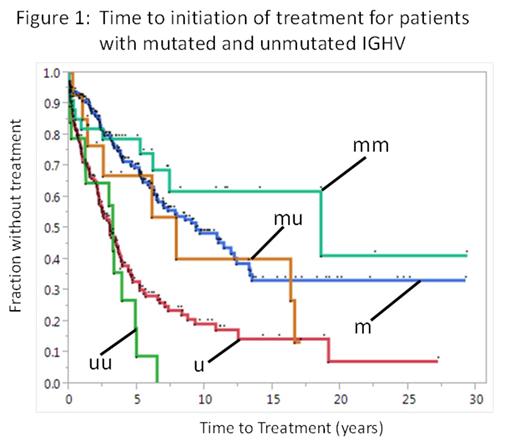Abstract
Background: Chronic lymphocytic leukemia (CLL) is an incurable cancer of mature B-lymphocytes that infiltrate the bone marrow, secondary lymphoid organs, and blood. Much progress has been made during the past decade in understanding the pathogenesis and prognosis in CLL. Patients with unmutated immunoglobulin gene heavy chain variable region (IGHV) genes have inferior clinical outcomes when compared to patients with mutated IGHV. While there is robust data regarding clinical outcomes in patients with single IGHV rearrangements in CLL, there is limited data regarding double IGHV rearrangements. Thus, we investigated the prevalence of double IGHV rearrangements in our institutional cohort to determine molecular features and the prognostic significance of CLL cases with double IGHV rearrangements.
Methods: Patients with CLL receiving care at Duke University and Durham Veterans Affairs (VA) Medical Centers were enrolled into a longitudinal cohort study between 1999 and 2014. IGHV mutation analysis was performed on DNA from all study patients. Patients were followed clinically for disease progression, need for treatment, and overall survival. The primary end points were time to treatment (TTT) or overall survival (OS). Survival curves were estimated using Kaplan-Meier method. Statistical differences were tested using proportional hazards tests for a clinical significance of p < 0.05. CLL cell isolation and IGHV mutational analysis were done as we have previously described (BLOOD 109:1559-1567, 2007). Statistical analysis was performed using SAS enterprise guide 5.1 and JMP Pro 11.
Results: A total of 489 CLL patients were studied. Of these, 420 had one IGVH gene rearrangement (single IGHV; 86%). In 69 patients (14%), we amplified two IGHV rearrangements, indicating likely biallelic IGHV. The median TTT for the single IGHV group was 5.4 years, and the median OS for the single IGHV group was 15.3 years. For the double IGHV group, the mean TTT was 6.5 years (p = 0.44), and the median OS was 15.8 years (p = 0.73). Patients with single mutated IGHV (m) had better survival (median OS = 20.1 years) than those with single unmutated IGHV (u) (median OS = 11.3 yrs; p <0.001). There can be three possible combinations in the double IGHV group: double mutated (mm), mutated-unmutated (mu), and double unmutated (uu). The Table displays the differences in TTT and OS for the groups. In our cohort, the median TTT for those with a mutated double IGHV was longer (16.3 years) than for those with an unmutated double IGHV [median = 3.2 years; p < 0.01)]. Similarly, the median OS for those with mutated double IGHV was 33.6 years, while for those without a mutation it was 9.6 years (p < 0.01). In general, the TTT and OS were longer in those patients that had a mutated IGHV versus those without. The number of mutated genes did not make a statistical difference in the patient outcomes. Similarly, when comparing the uu and u groups, there was no statistical difference in survival.
Conclusions: This is the largest single center study to date that examines double IGHV gene rearrangements and patient prognosis in CLL. The mutational status of the immunoglobulin heavy chain was a very important predictor of TTT and OS, mutated longer than ummutated. There was no significant survival difference between patients with single or double rearrangements in their IGHV chains. Our data demonstrates that the presence of at least one mutated IGHV gene confers a better prognosis for patients diagnosed with CLL. Thus, patients who have double IGHV rearrangements with at least one that is mutated, should be counseled as if they have a mutated rearrangement.
Statistical Analyses for Mutated and Unmutated IGHV for Time to Treatment and Overall Survival
| Time to Treatment . | TTT (years) . | m . | mu . | u . | uu . |
|---|---|---|---|---|---|
| p value (comparison between groups) | |||||
| mm | 18.5 | 0.156 | 0.168 | <.0001 | <.0001 |
| m | 9.4 | 0.603 | <.0001 | 0.0001 | |
| mu | 7.9 | 0.061 | 0.007 | ||
| u | 3.0 | 0.285 | |||
| uu | 3.2 | ||||
| Overall Survival | OS (years) | m | mu | u | uu |
| p value (comparison between groups) | |||||
| mm | 33.6 | 0.4899 | 0.623 | 0.007 | 0.016 |
| m | 20.1 | 0.612 | <.0001 | 0.001 | |
| mu | 20.8 | 0.096 | 0.053 | ||
| u | 11.3 | 0.099 | |||
| uu | 9.6 | ||||
| Time to Treatment . | TTT (years) . | m . | mu . | u . | uu . |
|---|---|---|---|---|---|
| p value (comparison between groups) | |||||
| mm | 18.5 | 0.156 | 0.168 | <.0001 | <.0001 |
| m | 9.4 | 0.603 | <.0001 | 0.0001 | |
| mu | 7.9 | 0.061 | 0.007 | ||
| u | 3.0 | 0.285 | |||
| uu | 3.2 | ||||
| Overall Survival | OS (years) | m | mu | u | uu |
| p value (comparison between groups) | |||||
| mm | 33.6 | 0.4899 | 0.623 | 0.007 | 0.016 |
| m | 20.1 | 0.612 | <.0001 | 0.001 | |
| mu | 20.8 | 0.096 | 0.053 | ||
| u | 11.3 | 0.099 | |||
| uu | 9.6 | ||||
Lanasa:MedImmune: Employment.
Author notes
Asterisk with author names denotes non-ASH members.


This feature is available to Subscribers Only
Sign In or Create an Account Close Modal